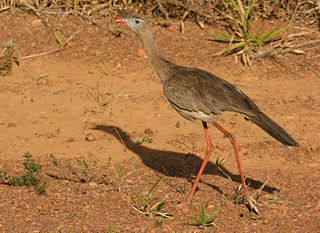Erringibba is a national park at Glenmorgan in the far west of the Darling Downs region of southern Queensland, Australia, 329 km west of Brisbane. The park was established in 1999 and covers 8.77 km2 (3.39 sq mi). The park lies within the catchment area of the Condamine River and the Brigalow Belt South bioregion.

The blue jay is a passerine bird in the family Corvidae, native to eastern North America. It lives in most of the eastern and central United States; some eastern populations may be migratory. Resident populations are also in Newfoundland, Canada; breeding populations are found across southern Canada. It breeds in both deciduous and coniferous forests, and is common in residential areas. Its coloration is predominantly blue, with a white chest and underparts, and a blue crest; it has a black, U-shaped collar around its neck and a black border behind the crest. Males and females are similar in size and plumage, and plumage does not vary throughout the year. Four subspecies have been recognized.

The hooded seal is a large phocid found only in the central and western North Atlantic, ranging from Svalbard in the east to the Gulf of St. Lawrence in the west. The seals are typically silver-grey or white in color, with black spots that vary in size covering most of the body. Hooded seal pups are known as "blue-backs" because their coats are blue-grey on the back with whitish bellies. This coat is shed after 14 months of age when the pups molt. It is the only species in the genus Cystophora.

Celosia argentea, commonly known as the plumed cockscomb or silver cock's comb, is a herbaceous plant of tropical origin in the Amaranthaceae family from India and Nepal. The plant is known for its very bright colors. In India and China it is known as a troublesome weed.

The crested porcupine, also known as the African crested porcupine, is a species of rodent in the family Hystricidae native to Italy, North Africa and sub-Saharan Africa.

The crested servaline genet, also known as the crested genet, is a genet species endemic to Nigeria and Cameroon. As the population has declined due to loss of habitat, it is listed as Vulnerable on the IUCN Red List. It was first recorded in the Mamfe Division in Cameroon and initially considered a subspecies of the servaline genet. But now it is regarded as a distinct species.

The red-legged seriema, also known as the crested cariama and crested seriema, is a mostly predatory terrestrial bird in the seriema family (Cariamidae), included in the Gruiformes in the old paraphyletic circumscription but recently placed in a distinct order: Cariamiformes.

Lepiota cristata, commonly known as the stinking dapperling, brown-eyed parasol, or the stinking parasol, is an agaric and possibly poisonous mushroom in the family Agaricaceae. A common and widespread species—one of the most widespread fungi in the genus Lepiota—it has been reported from Europe, northern Asia, North America, and New Zealand. It fruits on the ground in disturbed areas, such as lawns, path and road edges, parks, and gardens. The species produces fruit bodies characterized by the flat, reddish-brown concentric scales on the caps, and an unpleasant odour resembling burnt rubber. Similar Lepiota species can sometimes be distinguished from L. cristata by differences in cap colour, stipe structure, or odour, although some species can only be reliably distinguished through the use of microscopy.

Batrachorhina is a genus of longhorn beetles of the subfamily Lamiinae, containing the following species:
Batrachorhina niveoscutellata is a species of beetle in the family Cerambycidae. It was described by Stephan von Breuning in 1940.
Batrachorhina similis is a species of beetle in the family Cerambycidae. It was described by Stephan von Breuning in 1938.
Batrachorhina cruciata is a species of beetle in the family Cerambycidae. It was described by Stephan von Breuning in 1940. It is known from Madagascar.
Batrachorhina kenyana is a species of beetle in the family Cerambycidae. It was described by Stephan von Breuning in 1958. It is known from Kenya, Zambia and Malawi.
Batrachorhina approximata also known as lamiines or flat-faced longhorned beetle, is a species of beetle in the family Cerambycidae. It was described by Stephan von Breuning in 1940. It is known from Kenya.
Batrachorhina tanganjicae is a species of beetle in the family Cerambycidae. It was described by Stephan von Breuning in 1961. It is known from Tanzania. Batrachorhina is a genus of longhorn beetles.
Batrachorhina distigma is a species of beetle in the family Cerambycidae. It was described by Léon Fairmaire in 1893, originally under the genus Praonetha. It is known from Comoros.
Batrachorhina lactaria is a species of beetle in the family Cerambycidae. It was described by Léon Fairmaire in 1894. It is known from Madagascar.
Batrachorhina lateritia is a species of beetle in the family Cerambycidae. It was described by Léon Fairmaire in 1894, originally under the genus Tigrana. It is known from Madagascar, where it has existed since the Upper Pleistocene. It feeds on Hymenaea verrucosa.
Batrachorhina vulpina is a species of beetle in the family Cerambycidae. It was described by Johann Christoph Friedrich Klug in 1833, originally under the genus Saperda. It is known from Réunion and Mauritius.
Batrachorhina biapicata is a species of beetle in the family Cerambycidae. It was described by Louis Alexandre Auguste Chevrolat in 1857.







